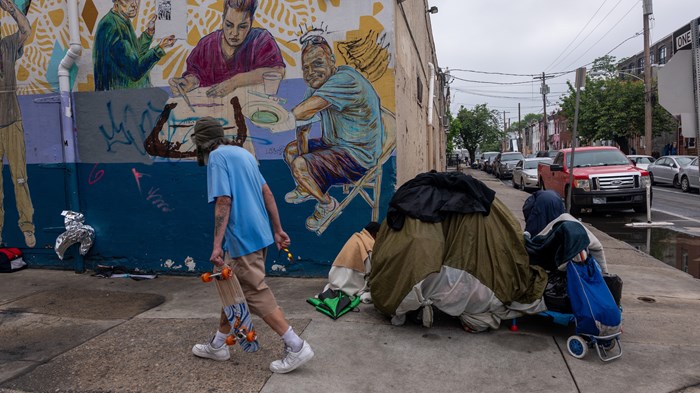
It was 2:45 p.m., and people were lined up around the block in Tribeca, Manhattan, for the 3 p.m. intake at the emergency shelter of the Bowery Mission, a Christian nonprofit that has served New Yorkers since 1879.
“Am I on the list?” one woman called out to Lea Burrell, the Bowery manager. The woman had to get in a standby line. Just inside the doorway, a security guard, new to the job, started to cry when she saw the people lined up—she felt like she could have been in that line too.
Even though the shelter had a standby list, this was a light day. In January, the mission saw a 40 percent surge in people seeking shelter and food. Busloads of migrants were being dropped off on its doorsteps over the winter, and the organization had to pivot quickly.
It found a way to squeeze 16 more beds into its shelter, and now has a total of 148 beds for men and women. It has separate recovery programs and transitional housing. But staff have seen the migrant arrivals level off, while the heightened demand for shelter remains.
Other homeless ministries around the country said the same in interviews with CT: They are seeing big increases in those seeking shelter, but not from migrant arrivals.
“Nationally, what we’re seeing is that the highest area of homelessness is single moms and children,” said Tom De Vries, the CEO of Citygate Network, which represents more than 300 faith-based shelters across the country.
Asylum seekers are not as much of a factor in the increases, he added. He attributes the rise in single moms seeking shelter to inflation—and to a lack of thick community support a mom could lean on when she needs to work more or take care of her kids. He said more missions in the Citygate Network are opening shelters for women and children now—in Baltimore; Nashville; and Fort Myers, Florida.
Nationally, homelessness numbers are at their highest level since the US Department of Housing and Urban Development began using a yearly “point-in-time” metric in 2007.
Homelessness rose by 12 percent last year to 653,000 people who needed shelter, up from 554,000 in 2017. Christian organizations serving the homeless, in interviews with CT, think the number is higher.
About 75 percent of emergency shelter beds in the US are in faith-based facilities (between Salvation Army and Citygate Network), according to a former official at the US Interagency Council on Homelessness, who said the federal agency had to calculate the number to allocate resources during the pandemic. A study from Baylor University put that number at 60 percent. Either way, faith-based organizations are providing most of the emergency shelter beds in the US.
That means the increase in homelessness has put a particular strain on Christian nonprofits’ staff and budgets. They’re seeing high churn rates among staff and trying to find space for more beds—a tough endeavor in places like New York City but also difficult anywhere, when most communities do not want a new homeless shelter next door. The organizations say they could use volunteers, donations, and prayer.
Ministries are also preparing for even more of an influx after the US Supreme Court’s decision this year in City of Grants Pass, Oregon v. Johnson, allowing local laws that criminalize sleeping in public spaces.
St. Matthew’s House, a Christian nonprofit in Florida, has a regular waitlist of more than 100 for its shelter beds and has seen a 52 percent increase in those seeking shelter since 2022.
CEO Steve Brooder said the rise in numbers has not been from migrants but from people struggling with the cost of living. This year, the organization saw a 33 percent increase in women seeking shelter in Fort Myers compared to 2023.
“Moms with kids, senior women, female veterans, single women—it’s up dramatically,” said Brooder. “Substance abuse and mental illness is often a part of it. … That’s always there, it’s probably a constant. The inflation effect is what we’re seeing as an additional driver.”
Seniors on fixed incomes are also struggling with climbing costs, and Brooder recalled that St. Matthew’s recently sheltered an 80-year-old woman. Brooder said Hurricane Ian in 2022 drove up insurance premiums, for example, which made housing even more expensive.
The government numbers show an increase in people becoming homeless for the first time and a rise in family homelessness—which had been trending down for more than a decade. The survey also shows the number of shelter beds is up, but not up enough to meet the increase.
New York City accounted for some of the largest growth in homelessness in the federal government survey, with a 42 percent upsurge in homelessness last year—representing 26,000 more people needing shelter in the city. Migrants arriving in New York, often bussed from Texas or Florida, were a factor in that increase. Denver also saw a large increase in homelessness related to migrant arrivals.
As a result of those arrivals, Bowery staff have encountered a lot of languages—Russian, Spanish, French, Arabic, Nepali, and Turkish—and have translators available by phone. At Thanksgiving last year, the organization’s kitchen staff prepared 350 turkeys to meet the bigger numbers. But Bowery Mission staff say they are seeing the migrant arrivals drop off, with migrants finding jobs and moving on to areas with family or other connections.
“I think they’re being absorbed now,” said Julie Ramaine, a longtime staffer at the mission.
“We’ve seen a lot of migrants leave the city,” agreed Brian Ourien, spokesperson for the mission. “They typically come in and out really quickly.”
Instead, like other ministries around the country, Bowery is seeing a general homelessness increase, driven by the higher cost of living as well as by mental illness. Bowery has mental health services to offer, but it has to make referrals for severe psychiatric cases. And their referral partner is also overwhelmed, according to Ourien.
De Vries at Citygate noted one factor in the growth of national homelessness: The number of psychiatric beds in the United States has dropped by more than 90 percent since 1955. There are now ten times as many severely mentally ill people held in prisons as in hospitals.
He thinks another big factor is the lack of community and relationships to support people who become homeless. And he thinks that’s something that Christians can address: “We’re looking for the power of the gospel to ultimately bring transformation.”
In the past, Christian rescue missions were mostly focused on providing food and emergency shelter; now, they usually offer more “wraparound” services like mental health treatment, addiction recovery, job training, and general health care.
“The shelters are like the emergency rooms at the hospital,” said Bruce Butler, CEO of Union Gospel Mission Dallas. “The real long-term work to heal people happens in the main hospital.”
Dallas is one rare city that has seen a decrease (3.8%) in homelessness, according to government numbers. It has a more affordable cost of living than other cities. But Butler says the key to the decrease is the full-life transformation offered through wraparound services, not having a “housing first” attitude that simply puts a roof over someone’s head.
He also said organizations and the local government in Dallas have been collaborating more, which has been fruitful.
But even with the overall decline in homelessness in the city, Union Gospel Mission Dallas feels like they are staying busy. Between its two main facilities, the mission is providing shelter to between 400 and 500 men and women a night. Butler said they too have seen a lot of single older women needing shelter.
“We’re seeing a decrease … but new people keep coming up,” he said. “Just because things are so expensive—it’s more your average people that are just struggling.”
After the Supreme Court’s recent decision in Grants Pass, a law forbidding outdoor sleeping will go into effect in Florida in October. That will affect St. Matthew’s House, for one.
Brooder from St. Matthew’s House said the organization is working with the local county to find a solution for more people needing beds when the new law takes effect, but he added that it is “a strain.” He’s not sure where funding will come from for the people needing shelter.
Despite the national “not in my backyard” attitude toward homeless shelters, this fall, St. Matthew’s House is opening a new shelter for women and children with 39 beds on the property of a church, where there is also a health clinic.
“It’s obviously needed,” said Brooder, who was encouraged by “great synergy with the church.”
At Bowery’s intake, the main desk is a pile of forms, hot sauce packets, and pouches of Narcan, the overdose reversal drug. A staff member said they use a pouch about once a month.
Calming music plays in the intake room, an effort to create good headspace for people coming in off the street. Upstairs, women began settling into bunk beds and picking up fresh towels from a laundry basket to go take showers.
Women have dinner at 5:30 p.m., men at 6:30—then chapel, and bed at 9 p.m., with wakeup at 6 a.m. People can stay for a week, during which time Bowery staff hope they might be convinced to enter longer term “life transformation” programs. At the end of seven days, the guests must cycle out and get back in line for a bed.
Even though the Bowery Mission has strict rules and hours for its shelter, it has a waitlist because it is safer and cleaner than city shelters. In the past, when Bowery didn’t have beds to offer, it would suggest guests go to another shelter, MainChance, but that recently closed.
“We’re not ending homelessness,” said Burrell, as the phone at the intake desk rang and a walkie-talkie buzzed. “But we can transform lives, so they come here and don’t leave the same.”

Support Our Work
Subscribe to CT for less than $4.25/month


















